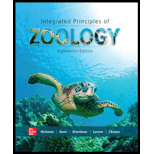
Concept explainers
To explain: The utility of the radial symmetry for free-floating animals and sessile.
Introduction: The Cnidarians are a phylum of simple animals. It includes jellyfish, hydras, corals, and sea anemones. The Cnidarians are divided into major classes, namely the Scyphozoa, Anthozoa, Staurozoa, and Hydrozoa.
Explanation of Solution
The body plans of most multicellular organisms exhibit some form of symmetry. It includes whether bilateral or spherical and radial. The radial symmetry is suitable for slow-moving organisms such as starfish and free-floating animals such as jellyfish. Especially, the radial symmetry is suitable for sessile animals.
The presence of radial symmetry allows an organism to interact with environments in all directions from one point. The radial symmetry is useful because the animals can just sit down and grab food from all the directions.
The radial symmetry also helps the animals to receive stimuli from all the directions. Thus, it builds up an efficient and strong defense mechanism. Therefore, the presence of radial symmetry is useful for both free-floating and sessile animals.
Want to see more full solutions like this?
Chapter 13 Solutions
Loose Leaf For Integrated Principles Of Zoology
- Explain the differences between the two types of shellfish and provide three examples of each.arrow_forwardCompare radial and bilateral symmetry, and provideexamples of animals that exemplify each.arrow_forwardTabulate distinctive characteristics between lancelets,bony fish and cartilagenous fisharrow_forward
- The flexibility inherent in a segmented body plan was clearly important to crustacean evolution, but why are crustaceans so much more diverse than annelids, another segmented taxon?arrow_forwardDifferentiate between Monohybrid and Dihybrid.arrow_forwardDistinguish between polyp and medusa forms.arrow_forward
 Biology: The Dynamic Science (MindTap Course List)BiologyISBN:9781305389892Author:Peter J. Russell, Paul E. Hertz, Beverly McMillanPublisher:Cengage Learning
Biology: The Dynamic Science (MindTap Course List)BiologyISBN:9781305389892Author:Peter J. Russell, Paul E. Hertz, Beverly McMillanPublisher:Cengage Learning Biology (MindTap Course List)BiologyISBN:9781337392938Author:Eldra Solomon, Charles Martin, Diana W. Martin, Linda R. BergPublisher:Cengage Learning
Biology (MindTap Course List)BiologyISBN:9781337392938Author:Eldra Solomon, Charles Martin, Diana W. Martin, Linda R. BergPublisher:Cengage Learning


